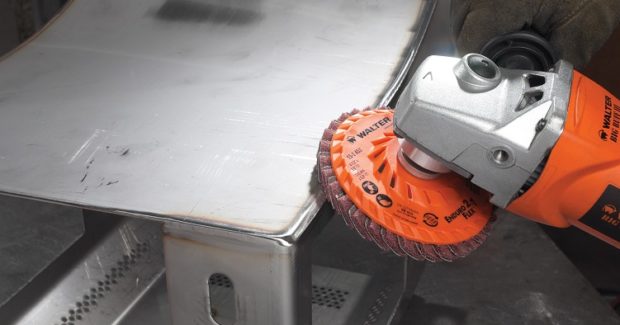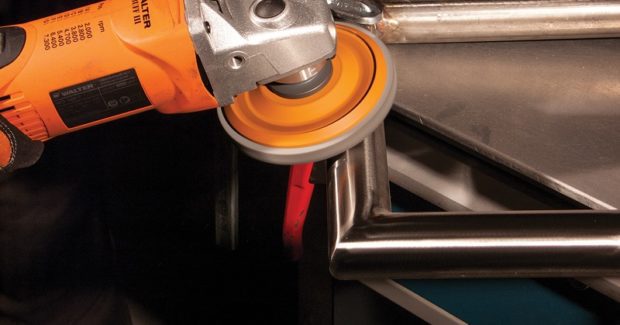Finishing Stainless Steel: The Ten Essentials
Finishing stainless steel is expensive because it requires a significant amount of time, more skilled labor, and mistakes can have a big impact on quality and productivity. To maximize efficiency and your bottom line in achieving any finish – whether it be a #4 sanitary finish or a #8 mirror finish – be sure to follow these ten best practices.
Posted: January 2, 2019
Stainless steel is one of the most widely used metals in manufacturing. Its corrosion resistance, cleanliness and aesthetic appeal make it a perfect choice for use in the construction, food and beverage, and pharmaceutical industries. However, working with stainless steel is not without its challenges. For one, it is three times more expensive than steel. Finishing stainless steel requires a significant amount of time and requires more skilled labor – mistakes can have a big impact on quality and productivity. This makes working with steel even more expensive, therefore, reducing the number of steps to a certain process is crucial in order to avoid costly rework. Workers should be equipped with the proper tools and should be kept up-to-date with the latest trends and technologies. To achieve any finish, whether it be a #4 sanitary finish or a #8 mirror finish, be sure to follow these ten best practices to maximize efficiency and your bottom line:
1. START AT THE FINISH
Determine the desired finish, or application, before you begin the finishing process. This will allow you to map out the entire process, determine exactly what products you’ll need at each step. This will help you save both time and money by avoiding any unnecessary steps. For example, you may end up having to repair deep scratch patterns because the selected abrasive was too coarse.
2. CLEAN BEFORE YOU START
Always clean your workpiece before starting any finishing job to remove contaminants on the surface. By doing so, you’ll avoid smearing grease on the surface, which can clog your abrasives. You can also avoid making deeper scratches that will require more work to fix.
3. CHOOSE THE RIGHT ABRASIVE
Keep in mind that the type of abrasive you choose can have an effect on your overall process. Choosing the least expensive consumable, while appealing up front can result in poor quality and additional downtime for wheel changeover. Using low quality products can also impact the final result and cause problems to the workpiece in the long term. The protective chromium oxide layer on stainless steel can breakdown when exposed to heat and acids. To keep this layer intact, always use abrasives designed for use on stainless steel. These abrasives will be free of iron, sulfur and chlorine, and will not contaminate stainless steel.
4. WATCH YOUR GRIT SIZES
When removing a weld bead from the surface, choose your grit carefully. An abrasive that’s too coarse could gouge the surface, making a smooth blend impossible, ruining your workpiece. To go from a coarse finish to a finer one, we do not recommend skipping more than three grit sizes at a time. If you need to combine steps, we have solutions that can help you do that.
5. PRACTICE CROSS GRINDING
Cross grinding is a technique used in finishing and polishing that involves blending in a direction that’s perpendicular to the previous step. Cross grinding is important because it highlights areas where the previous scratch pattern needs to be blended.
6. PAY CLOSE ATTENTION TO PRESSURE AND ANGLE
Getting the pressure and angle right when grinding is a must. As a general rule, you should apply more pressure when removing material (taking down a weld, for example) versus polishing. Applying the right pressure and angle keeps the material from overheating and prevents discoloration, surface gouges and warping.
7. USE THE RECOMMENDED RPM
All finishing power tools have variable speed, and each abrasive is recommended for use at a specific speed. It’s important to respect those recommendations so you can achieve a better, faster finish and a guaranteed perfect result without the need for rework. The abrasives will last longer as well. They won’t wear down prematurely, and they won’t glaze or lose their efficiency due to running too slowly.
8. SELECT THE RIGHT POWER TOOL FOR THE JOB
Consider the shape of the workpiece. Are you working with square or circular tubing? Will you need to finish inside or outside corners? The specific shape of the workpiece can cause certain constraints, and it is not beneficial to cut any corners (no pun intended) by using the wrong tool for the job. For example, a pipe sander would be best for working on a straight circular tube, but getting to an inside corner will require a fillet weld grinder. Most importantly, for any finishing application, you will need a variable speed power tool to achieve the best results.
9. FOLLOW STANDARD SAFETY PRACTICES
This may seem obvious, but taking the necessary safety precautions not only prevents accidents, injuries, fatalities, and downtime, but also enhances employees’ health, well-being, productivity, and work quality. Be sure to use the appropriate PPE items for eye, face, hearing, hands and respiratory protection. When working with a finishing power tool, a safety guard must be in place to protect the operator from the moving abrasive surface and to deflect flying fragments from the workpiece or the abrasive product itself. We strongly recommend unplugging the power tool prior to mounting the abrasive product, and between steps while operators switch products.
10. FINISH THE PROCESS WITH CARE
Once you’ve achieved the desired finish and a passive surface, it’s important to remove any dirt, dust, fingerprints, handling marks, and oils and to protect the surface. Be sure to use a product specifically designed for use on stainless steel. For example, our E-Nox Shine™ is ideal for cleaning, brightening, and protecting stainless steel surfaces. Plus it is safe for use in the food and pharmaceutical industries.






